Győr, belső keleti tehermentesítő út – Mosoni-Duna híd
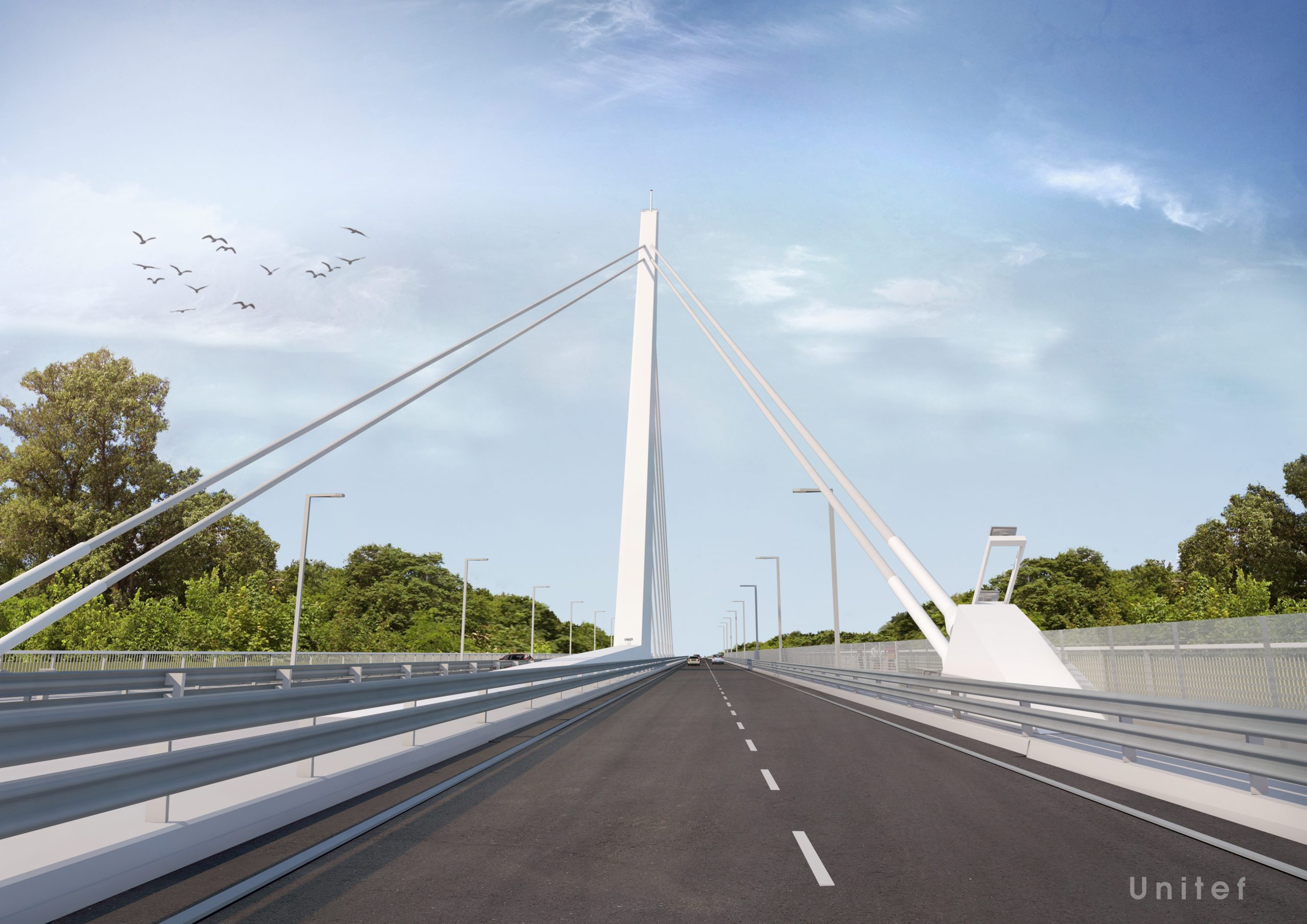
| Categoría | Proyectos de infraestructura |
|---|---|
| Año | 2021 |
| País | Hungary |
| Organización | UNITEF'83 Műszaki Tervező és Fejlesztő Zrt. |
| Autor | Kővári Ákos |
| Coautores | Bartus Róbert, Berta Richárd, Halwax András, Egyed Veronika, Simon Viktória DLA, Tóth Domonkos, Taierling János, Németh Gábor, Szepessy Gábor, Székely Márta |
| Cliente | UNITEF'83 Zrt. |
| Lugar de construcción | Győr, Hungary |
| Tags |
A magyarországi infrastruktúra beruházó NIF Zrt. megbízást adott az UNITEF’83 Zrt.-nek a győri keleti tehermentesítő út, valamint az új Mosoni-Duna híd tervezésére. A Mosoni-Duna a főágból Dunakiliti és Dunacsúny között ágazik ki és a Szigetközt déli irányban megkerülve Gönyűnél torkollik újra a Dunába. A Mosoni-Duna Győrön is áthalad, ahol a tehermentesítő út építése során új látványos híd épül a folyó felett.
Cégünk több tanulmánytervi változatot készített, melyből a megrendelő és a város vezetése egy látványos ferdekábeles hidat választott ki. A szerkezetválasztásnál fontos szempont volt, hogy az új híd legyen egyedi megjelenésű, modern formavilágú, ugyanakkor a városi fejlesztésekhez is igazodjon.
A megvalósítandó hídszerkezet vasbeton alépítményeken nyugvó egypilonos kialakítású ferdekábeles acélszerkezet. A különleges látványt a meder feletti egysíkú kábelvezetés, valamint a hídfőknél kétirányban oldalra vezetett pászmák jelentik. Emellett látványos elem a 67 fokban dőlő, prizmatikus (lapszerű) formákból felépülő csökkenő keresztmetszetű pilon.
A hídszerkezet teljes hossza: 213,6 m, támaszközök: 144 m és 68 m, a szerkezet magassága: 66,74 m, a teljes szerkezet súlya 3906 t. A híd 2×2 sávos közúti forgalmat, valamint kerékpárutat és gyalogjárdát vezet át. Hídszélesség: 29,73 m.
A hídszerkezet kiviteli terveit Trimble Tekla Structures 2019i program felhasználásával készítettük el. A modellezés során számos új, megoldandó feladattal szembesültünk, mely a hídszerkezet egyedi látványvilágából adódott. A modellezés során (bár a kivitelezői tender nyertese még nem ismert) igyekeztünk a későbbi kivitelezés szempontjából optimális elemosztásokat meghatározni. A szerelési egységek meghatározásánál figyelembe kellett vennünk, hogy az elemek, csak közúton szállíthatók a helyszínre, mert a folyót a kis mélysége miatt organizációs szempontból nem tudjuk igénybe venni. Szintén komoly megfontolásokat igényelt, hogy a híd alakbeállítását hogyan végezzük el. Ehhez ideiglenes segédjármok épülnek a folyóba, melyre betolásra kerül a merevítőtartó. A jármok megadják a híd alakját, így a feszítést a járomról való elemelkedésre optimalizáltuk. További megoldandó probléma volt a merevítőtartó túlemelésének biztosítása. Külön TEKLA modellen meg lett vizsgálva az illeszkedő élek szögfelezőbe történő legyártása is. Itt azonban nagyon kis eltérések adódtak. Ezért végül a szerelési egységek ortogonális rendszerben készülhetnek, a túlemelési alakot pedig a gyökméret változtatásával biztosíthatja a kivitelező. A híd legnagyobb kihívását a pilon modellezése jelentette. A T bordákkal merevített zártszelvény lineárisan változó elemeit kellett modelleznünk. A megadott helyeken ezen túl kábelbekötési pontokat is biztosítani kellett. A modellezés elforgatott síkkal történt. Az elforgatott alapsík a meder felőli 67 fokban dőlő sík volt. Erre kerültek felszerkesztésre az alkotó elemek és a bordák. Így elérhetővé vált, hogy az illesztési hézagok, valamint a meder felőli oldal elemei ortogonális rendszert alkotnak. Komplikált geometriai szerkesztés így a pilon hátsó oldal határoló lemezeire korlátozódott. A híd egyedi szerkezetéből adódóan számos részletet kellett kidolgoznunk: lehorgonyzó elemek a merevítőtartó végein, kábellehorgonyzások, sarucsomópontok, pilon-merevítőtartó kapcsolata.
Összességében számos előnnyel járt a 3D programhasználat. Pl.: azonnali vizualizáció, térbeli ütközések egyszerű vizsgálata, parametrizálható elemszámozás, adatszolgáltatás látványtervek készítéséhez. Reményeink szerint a gyártás során a felépített modellünk felhasználható lesz a méretpontos gyártmányok elkészítéséhez. Cégünk több éve alkalmazza az infrastruktúra tervezéseink acélszerkezeti vonatkozásaiban a TEKLA programot, azonban a Mosoni-Duna híd mind komplexitásában, mind egyediségében kitűnik ezek közül. Ezen okok miatt nevezzük projektünket a TEKLA BIM Awards 2021. díjra.
Beruházó: NIF Zrt.
Tervező: UNITEF’ 83 Zrt.
Tervezők: Bartus Róbert Irodaigazgató, Kővári Ákos felelős tervező, Berta Richárd acélszerkezeti tervező (3D modellezés – merevítőtartó, elvi építéstechnológia), Halwax András acélszerkezeti tervező (3D modellezés – pilon), Taierling János (vasbeton szerkezetek, statika), Szepessy Gábor (statika, földrengés számítás), Németh Gábor (statikai-, széldinamikai vizsgálatok), Székely Márta (részlettervezés) Simon Viktória DLA építésztervező, Tóth Domonkos (látványtervek)
The Hungarian National Infrastructure Development Private Company Limited (Nemzeti Infrastruktúra Fejlesztő Zrt. – NIF) gave the assignment to design Győr’s eastern relief road and the new Mosoni-Duna river bridge. The Mosoni-Duna river bifurcates from the main stream of Duna between Dunakiliti and Dunacsúny. After circling around Szigetköz the Mosoni-Duna river will conflate back with Duna. The Mosoni-Duna crosses Győr where the relief road demands a new esthetic bridge above the river.
Our company came up with numerous design plans. Ultimately the client and the city choose our cable stayed draft. The most important aspects were the unique look, a modern shape, and to fit well with the city’s development endeavor.
The structure is a cable stayed bridge with single pylon and reinforced concrete substructure. The orientation of the pylon, the single cable plane above the river bed, and the forking of the anchor cables give the unique look for the bridge. The pylon has 67-degree inclination forward and the area of its cross section is shrinking with height.
Length of the structure: 213,6 m
Spans: 144 m and 68 m
Height of the structure: 66,74m
Total weight: 3906 t
Width of the structure: 29,73 m
The capacity of the bridge is 2×2 lanes of roadway, two bicycle lanes and a pedestrian side-walk
The steel technical drawings were made with Trimble’s Tekla Structures 2019i. From the first steps 3D modelling gave us a powerful tool to present, shape and share our idea of the bridge. Although given the complexity of the geometry we encountered numerous obstacles during modeling. We aimed to find the optimal size for the construction segments. We were restricted by the fact that the segments could only be transported on roadways. The river proved to be too shallow to move parts. It also took serious consideration how to achieve the designed shape of the centerline. In the end we decided to use incremental lunching method on temporary supports built on the river bed. The temporary supports will provide the shape of the centerline and optimal cable stress will be reached when the structure is lifted from the supports. We analyzed the difference between a curved and an orthogonal model. The geometrical error at the joints were so negligible that it can be solved with different weld sizes. The hardest part of the modeling process was the pylon. The linearly changing cross section is designed with “T” stiffeners. We had to solve the collision between the stiffeners and the cable anchoring plates while there were no parallel boundary plates. Additionally, to achieve the most slender shape possible we analyzed contractibility. The model gave us a powerful tool to provide just enough space for the building technology of post tension cables.
To create the pylon we assigned the workplane to the river side boundary plates. In that 67-degree tilted plane we modeled the joints between construction segments and riverside plates in orthogonal system. These plates then served as basepoints for the complicated 3D modelling for the rest of the pylon. Given the complexity of the bridge there were numerous details left for modeling: Cable anchoring for both the main span and for the anchoring cables at the end of the girder, the joint connection and vicinity of the bearings, and the connection between the pylon and girder.
In conclusion using 3D software proved to have numerous advantages. From visualization, collision analysis, parametric element marking, to examine the contractibility. We except our model to be useful for accurate fabrication. For numerous years our company utilizes Tekal Structures in infrastructural projects, however the Mosoni-Duna bridge stands out both in complexity and uniqueness. For this reason, we decided to enter the BIM Awards competition.
Client: National Infrastructure Development Private Company Limited (Nif Zrt.)
Designer company: UNITEF’83 Zrt.
Designers: Róbert Bartus Office Director
Ákos Kővári: Lead Engineer
Richárd Berta: Structural Engineer (3D modeling – girder)
András Halwax: Structural Engineer (3D modeling – pylon)
Tailerling János: Structural Engineer (superstructure and substructure analysis)
Gábor Szepessy: Structural Engineer (superstructure and seismic analysis)
Gábor Németh: Structural Engineer (superstructure and aerodynamic analysis)
Márta Székely: Structural Engineer (Detail designer)
Viktória Simon: DLA Architect (architectural design)
Domonkos Tóth: Architect (visualization)
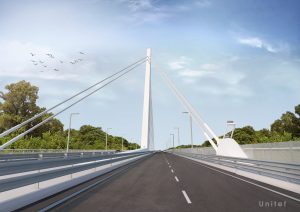
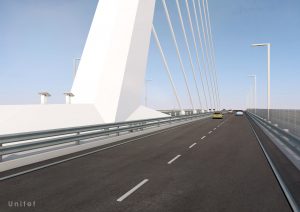

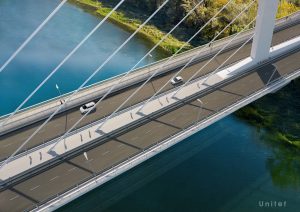
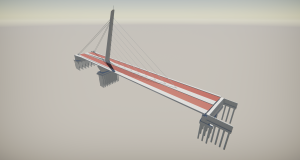
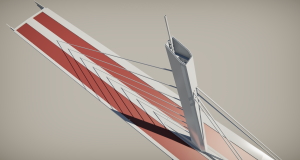
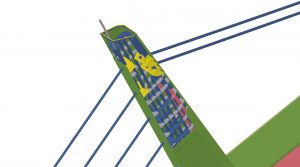

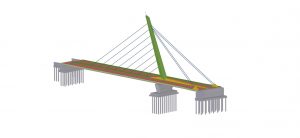

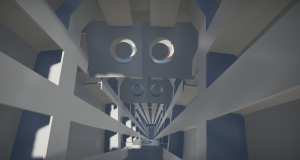
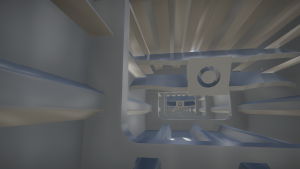

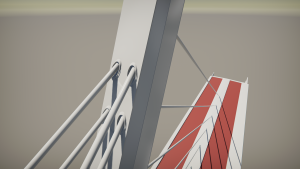

Gratulálok az Unitef-nek és remek tervező csapatának! Városomnak, Győrnek ékköve lesz ez a híd!
Szép munka! Öröm látni, hogy fejlődik szépül, épül a szülővárosom. Köszönöm szépen.